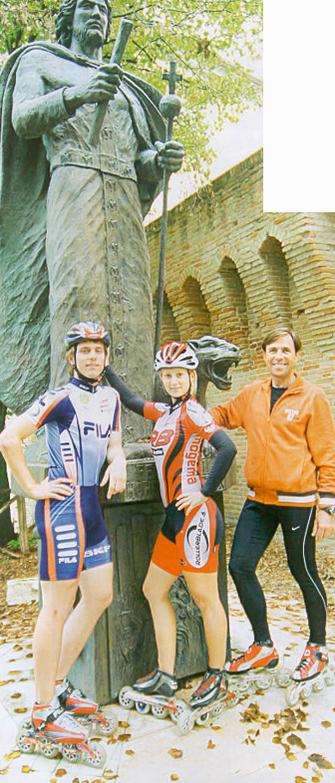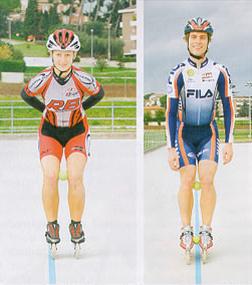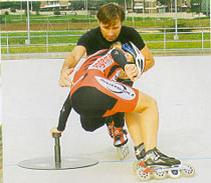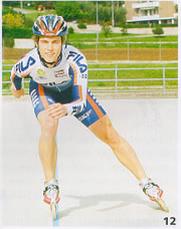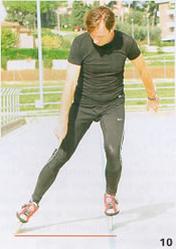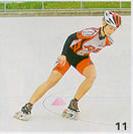<%@LANGUAGE="VBSCRIPT"%>
Abc -english
In
the first article, I defined the general in-line skating concepts. The right
use of them will permit the achievement of a valid technical model.
I will now present a sequence of exercises on skates in this second article
on:
a)
correct position: to find the right static and
dynamic position
b) awareness of movement control (developing kinaesthetic
analysis and self-awareness capabilities)
Description of the “straight-away push” and “corner push”
(crossover steps):
| STRAIGHT-AWAY
PUSH-SPRINT |
STRAIGHT-AWAY
PUSH-DISTANCE
“double push”
|
CORNER
PUSH
"crossover step" |
|
1.transfer
of body weight |
1.
transfer of body weight |
1.
body axis inclination |
|
2.
landing
|
2.
landing
|
2.
landing
|
|
3.
rolling
|
3.
simultaneous double push
|
3.
push *
|
|
4.
outside edge push
|
4.
double push
|
4.
lift
|
|
5.
inside edge push
|
5.outside
edge push
|
5.
calling back |
|
6.
lift
|
6.
inside edge push
|
|
|
7.
calling back |
7.
lift
|
|
|
|
8.
calling back |
|
*
counter-clockwise direction: outside edge push on left leg, inside edge push
on right leg.
ATTENTION:
I intentionally excluded in the STRAIGHT-AWAY PUSH-DISTANCE table the entry
“progressive dynamic rolling on outside edge”, the most used technique
by modern athletes, sprinters or distance runners. This function will produce
slowing down of the barycentre between step 2 and 3, even if “economically”
valid. The landing is done with the front of the skate intra rotated, the
skate’s pathway describes a kind of “letter s”, like the
double push … but it is totally different!!!
The different steps of the entry are as follows: 1-
transfer of body weight, 2- landing, 3- progressive dynamic rolling on outside
edge, 4- outside edge push, 5- inside edge push, 6- lift, and 7- calling back.
The coach’s aim is to teach correct technique and not leave free
interpretation to the athletes.
The teaching of these techniques has the defined goal to build mutual
technical models, which if correct, are useful and can be reproduced. These
are essential requirements to reach OUTSTANDING TECNIQUE.
In
the straight-away push –sprint, the “double grounding”
recorded time between phase 2 and phase 3, for a single leg, is around 2-4
hundreds of sec., while the other leg is pushing; considering also that the
barycentre speed is a bit lower (bio-mechanics 2002).
In the straight-away push-distance, the “double grounding”
recorded time between phase 2, phase 3 and phase 4, for a single leg, is around
12-14 hundreds of sec., while the other leg is pushing; the making of “the
real double push” doesn’t cause decrease in barycentre speed (bio-mechanics
1996).
In the corner push (crossover step), we record a simultaneous
alternating landing and lifting of the legs which produce a more homogenous
speed than the straight-away push (speed on track is above 12 meters x sec).
Only in the right leg landing we can find a “double grounding”
with the left leg of about 4-8 hundreds of sec. (bio-mechanics 2002).
It clearly
emerges from the 3 Tables that there are “different number of phases”
for each required technical execution and for each kind of race.
The number of phases to obtain is equivalent to the “final time”
of a complete cycle (of a single leg).
• straight-away push-sprint, from 38 to 42 hundredth
of sec.
• straight-away push-distance, from 60 to 75 hundreds
of sec.
• corner push, right leg from 26 to 30 hundreds of
sec., left leg from 30 to 36 hundreds of sec.

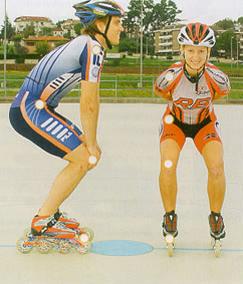
Phase
2: landing, is common to all techniques. Its recurring movements
will have an effect, positive or negative, on all the other phases. We must
also consider that the in-line skate landing is not found in any basic movement
pattern.
The landing point should be: a) with a vertical projection on the
ground of the corresponding “iliac spine” of the leg in movement,
b) with the skate front parallel to the advancing direction, c) with the skate
frame in vertical position, d) with the body weight equally distributed on
all the wheels (this is possible if the knee covers the first wheel).
PS: landing in advanced position to the iliac spine will cause the classic
landing in “last wheel-first wheel”.

Correct
position and self awareness exercises
Knowledge of the reference points
A. skate front-first wheel
B. knee
C. iliac spine
D. head of the homers
Aim:
to acquire knowledge of the four points is compulsory for a proper understanding
of the technical concepts that will follow.
1-Basic position and weight distribution
(staggered stance)
This exercise has always been presented in literature as the basic
main step. It is fundamental as the first position for young athletes. However
we must consider this step as “correct position and self awareness ”
exercise, since in any straight or curve execution the skater will never be
in this position.
The exercise is classified as propedeutic for learning and executing the landing
phase.
Aim: Line up the four reference points in order to have an
equal and correct weight distribution on the two skates.
Correct execution:
set the skates parallel at equal distance from the hip-bone (the
length between the two points C), move the knees forward (points B) to reach
the skate tip (points A). Line up shoulders (points D) with points A and B
bending the chest forward (it is easier to put hands on knees, with straight
elbows), the vertical line to the ground of the point C should be inside the
last wheel (see lateral picture).
Transfer
of body weight (“the windshield wiper”)
I would like to continuously remind that the transfer of body weight
on a frontal plane is not found in normal walking, running, jogging or jumping.
This fundamental step in the sequence of the straight-away push MUST
BE TAUGHT.
Aim:
learning the hip-bone movement on a frontal plane. This is the first elementary
step in a forward movement in a straight-away. It is important to acquire
this new motor pattern for in line skating.
Exercises
with skates on the ground
In the exercises with “pushes with skates on the ground”, the
two elements “width” and “breath”
must be equal, while the element “depth ” must have 0
value: The red line shows the first two wheels’ position on the same
line.
Single skate in straight-away (searching
for the “triangle” configuration)
Main target: to keep all the body weight on the bended leg, the athlete
will acquire the correct landing-advancement position (skate is always “under”
the hip-bone).
Secondary target: to learn the sideway extension of the pushing
leg with all wheels touching the ground.
Single
skate in curve (searching for the “triangle” configuration)
Main
target: to keep all the body weight on the bended leg, the athlete
will acquire the correct landing-advancement position (skate is always “under”
the hip-bone).
Secondary target: to learn the sideway extension of the pushing
leg with all wheels touching the ground.
Teaching with fantasy
The teacher should remember not to be a coach while teaching. In dealing with
children, it is useful to have multiple learning proposals, to discriminate
teaching styles and methods, to create a friendly and peaceful environment
with the group, to use always playful methods to obtain the basic techniques.
Knowing how to teach is extremely complex and the results will not always
be
immediately rewarding, but “good teacher”
with great experience knows that time will be his friend.
Techniques must be thought from the first day to the end of the sport career
of every athlete.
4
4a
4b
